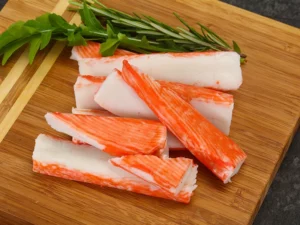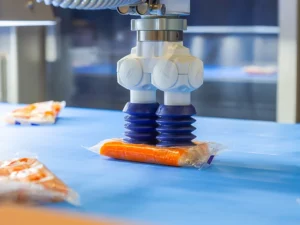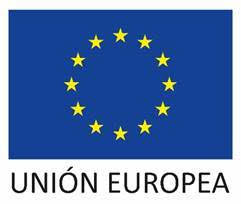Picking line for surimi packaging

The surimi sector and other processed seafood products
We recently had an application case of a company in the fish company in the fish derivatives sector
, which was dedicated to the manufacture and marketing of surimi, among other
products. They presented us with a problem that is recurrent in this sector, since it is not
the first time we have designed and developed machinery for such a case. What did the company need?

The challenge: A robotized line for surimi packaging
The customer carried out the packaging process manually, which implied a considerable investment in manpower. Because it was a repetitive and unrewarding task, the company was experiencing significant problems related to absenteeism and a high turnover rate, the company was experiencing significant problems related to absenteeism and a high turnover rate.
The product to be packaged in cartons are fresh surimi sticks, which arrive randomly and at up to 500 pieces per minute.
The challenge has been to develop an intelligent cartoningsystem using vision-guided robots . automaticcartoning system using vision-guided robots to pick up to pick up the surimi sticks arriving randomly from the randomly arriving from the pasteurizing and cooling unit, and place them correctly oriented on the trays or in the flowpack machine.

The solution: A picking line with product recirculation and artificial vision
We implemented a modular roboticcell equipped with artificial vision, ready to detect the product arriving from the production line and pick it up to deposit it in the required container at high speed. By means of a system of
vibrationfeeding, the products are separated and positioned so that they are recognizable by the robot ‘ s vision system. Additionally, if the robots do not pick a product, the product recirculation system, which consists of multiple conveyors, transfers those products back to the line infeed. For this application , a mixed 2D and 3D machine vision system was integrated. The 2D vision detects both product and color, This means that it always places the top layer with the correct product color. The 3D vision, in addition to having the same features as the previous one, allows to collect product assembled by recirculation.
What did we achieve?
01_
A significant reduction in waste thanks to a product recirculation system and vision cameras that allow the robots to pick up overlapped or stacked products.
02_
More accurate and hygienic operations.
03_
Avoid errors and injuries associated with manual operations, such as stress, new personnel, etc.
04_
Possibility to digitize line efficiency data.
